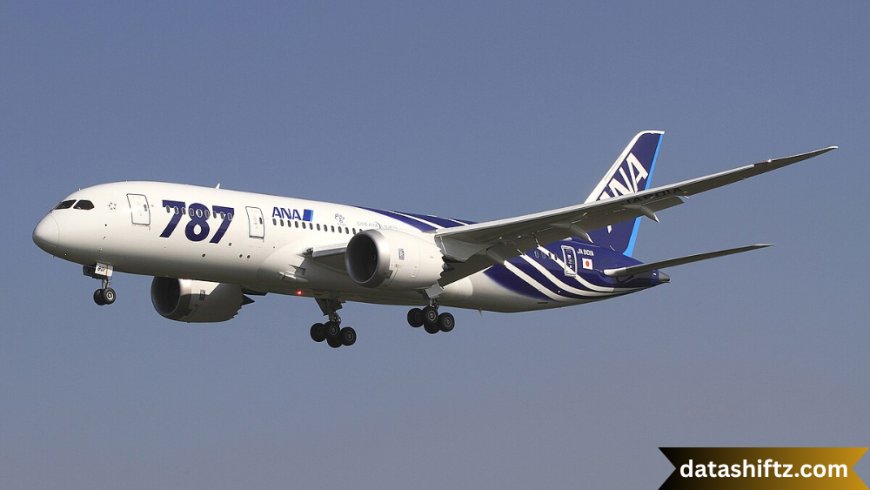Boeing 787 Dreamliner: Revolutionizing Air Travel in the 21st Century

Introduction
The Boeing 787 Dreamliner is more than just an aircraft; it is a testament to the evolution of aviation technology, passenger comfort, and fuel efficiency. Launched by Boeing Commercial Airplanes, the 787 series marked a paradigm shift in long-haul air travel by utilizing cutting-edge materials, systems, and engineering practices.
This revolutionary aircraft was designed with both airline operators and passengers in mind. While operators enjoy lower operating costs and fuel savings, travelers experience greater in-flight comfort thanks to improved cabin pressure, higher humidity levels, and larger windows.
In this article, we’ll explore the history, design innovations, technical specifications, variants, and impact of the Boeing 787 Dreamliner, making it a comprehensive guide for aviation enthusiasts, engineers, and frequent fliers alike.
Development History of the Boeing 787
Origins and Need for Innovation
In the early 2000s, Boeing recognized the need for a new generation of fuel-efficient aircraft to meet rising fuel costs and environmental demands. The result was the 787 Dreamliner, initially named the "Sonic Cruiser," which later evolved into a more fuel-focused project.
-
Announcement: 2003
-
First Flight: December 15, 2009
-
Commercial Entry: October 26, 2011 (with All Nippon Airways)
The aircraft was a collaborative effort involving suppliers from over 50 countries, with final assembly in Everett, Washington and North Charleston, South Carolina.
Key Design and Technology Innovations
The Boeing 787 Dreamliner features several groundbreaking technologies, making it a marvel in modern aviation.
Advanced Materials
-
Carbon Composite Materials: Over 50% of the primary structure (including the fuselage and wings) is made from carbon fiber-reinforced polymer.
-
Benefit: Lighter weight, better corrosion resistance, and lower maintenance.
Fuel Efficiency
-
20% more efficient than previous aircraft like the Boeing 767.
-
New Rolls-Royce Trent 1000 and GE Genx engines provide higher bypass ratios and quieter performance.
Aerodynamic Improvements
-
Raked wingtips and smooth wing-body integration enhance fuel performance.
-
Laminar flow control reduces drag and improves range.
Cabin Experience – Passenger-Centric Design
Boeing designed the 787 with the goal of offering unparalleled comfort for passengers on long-haul flights.
Key Passenger Comfort Features
-
Larger Windows: 65% bigger than standard aircraft windows, with electronic dimming.
-
Lower Cabin Altitude: Pressurized at 6,000 ft instead of the typical 8,000 ft.
-
Higher Humidity: Reduces dryness, jet lag, and fatigue.
-
Quieter Cabin: Engine nacelles and sound-absorbing materials ensure reduced noise levels.
-
LED Lighting System: Mimics sunrise/sunset to reduce jet lag and enhance mood.
Boeing 787 Variants and Their Uses
There are three main variants of the Dreamliner, each tailored for different market needs and flight ranges.
Boeing 787 Variants Comparison
| Feature | 787-8 | 787-9 | 787-10 |
|---|---|---|---|
| Length | 186 ft (56.7 m) | 206 ft (62.8 m) | 224 ft (68.3 m) |
| Passenger Capacity | 242 (2-class) | 296 (2-class) | 318 (2-class) |
| Range | 13,530 km (7,305 nmi) | 14,010 km (7,530 nmi) | 11,910 km (6,430 nmi) |
| First Delivery | 2011 | 2014 | 2017 |
| Primary Use Case | Long-haul, medium size | Longest range | High capacity, shorter range |
-
787-8: Ideal for thinner long-haul routes
-
787-9: Best balance of capacity and range
-
787-10: Designed for high-density regional and intercontinental routes
Airlines Operating the Dreamliner
Over 85 airlines worldwide operate the Boeing 787 across diverse continents.
Top Operators of Boeing 787 (as of 2025)
-
All Nippon Airways (ANA) – Launch customer
-
Qatar Airways
-
United Airlines
-
British Airways
-
American Airlines
These airlines deploy the Dreamliner on long-haul routes between Asia, Europe, North America, and Australia, ensuring efficient operations and enhanced passenger experience.
Economic and Environmental Impact
The 787 Dreamliner is not just a commercial success but a milestone in sustainable aviation.
Fuel and Emissions Efficiency
-
20–25% reduction in CO₂ emissions per seat compared to similar-sized aircraft.
-
Use of lightweight composites reduces fuel burn.
-
Lower maintenance costs over the aircraft's lifecycle.
Economic Benefits for Airlines
-
Fewer maintenance cycles thanks to advanced composite structure.
-
Higher dispatch reliability (~99.3%).
-
Ability to open “long thin routes” that were previously unprofitable.
Challenges Faced During Development
Despite its ultimate success, the 787 program faced several major setbacks.
Key Development Challenges
-
Delays in Production – Due to complex global supply chain.
-
Battery Issues – Lithium-ion battery fires grounded the fleet in 2013.
-
Cost Overruns – Estimated at over $32 billion.
-
Supplier Management – Difficulty coordinating international vendors.
However, Boeing overcame these issues with improved supply chain controls and design revisions.
Future of the Boeing 787 Program
Ongoing Orders and Production
As of 2025, Boeing has over 1,800 orders for the Dreamliner family, with more than 1,100 delivered. The aircraft continues to see strong demand due to:
-
Environmental regulations pushing airlines to retire older fleets
-
High fuel prices
-
Rising demand for long-haul travel post-pandemic
Future Outlook – Boeing 787 vs Competitors
| Aircraft Model | Manufacturer | Range | Passenger Capacity | Market Focus |
|---|---|---|---|---|
| Boeing 787-9 | Boeing | 7,530 nmi | 296 | Long-haul, fuel-efficient |
| Airbus A350-900 | Airbus | 8,100 nmi | 300–350 | Long-haul, wide-body |
| Boeing 777X (future) | Boeing | 7,285 nmi | 384–426 | Ultra-long haul |
Boeing 787 in India
Indian Carriers Operating Dreamliners
India’s flag carrier Air India was one of the early adopters of the 787-8 Dreamliner and currently operates one of the largest Dreamliner fleets in Asia.
In addition, Vistara has started integrating the 787-9 variant for international routes.
Benefits for Indian carriers include:
-
Cost-effective ultra-long-haul connectivity
-
Premium cabin experience
-
Lower emissions to align with sustainability goals
Conclusion
The Boeing 787 Dreamliner has redefined what it means to fly in the 21st century. From its lightweight composite materials and advanced engines to its passenger-centric cabin design and global versatility, the Dreamliner symbolizes the future of aviation.
Despite early setbacks, Boeing has managed to make the 787 a flagship aircraft for many of the world’s leading airlines. It is a product of innovation, resilience, and a clear vision for a better way to fly.
As we look to a future shaped by sustainability, efficiency, and customer satisfaction, the Dreamliner continues to soar, reminding us that the sky is not the limit—but only the beginning.






























